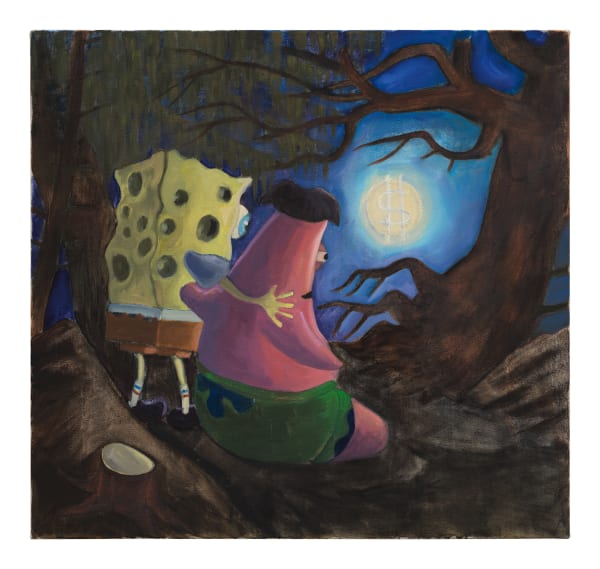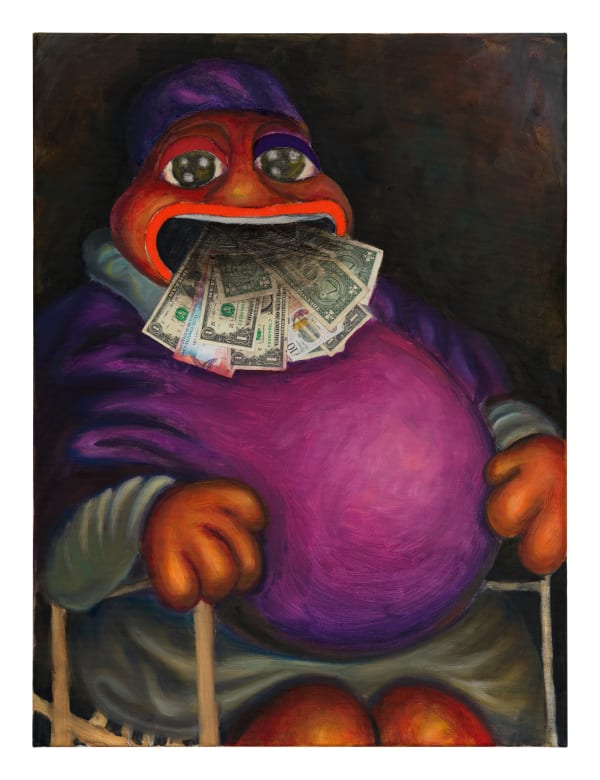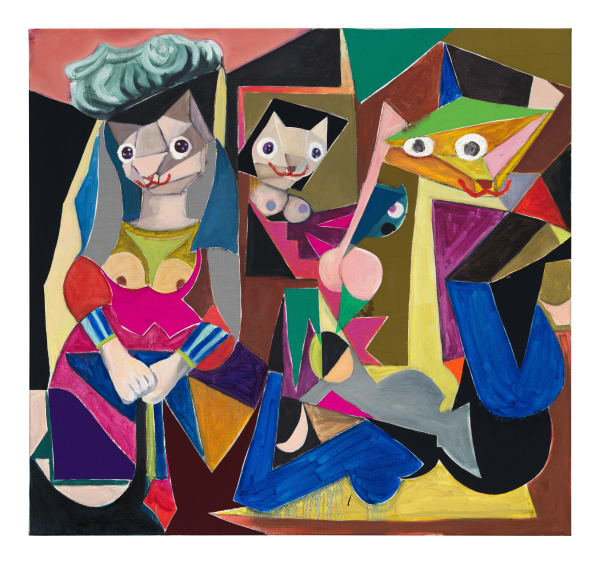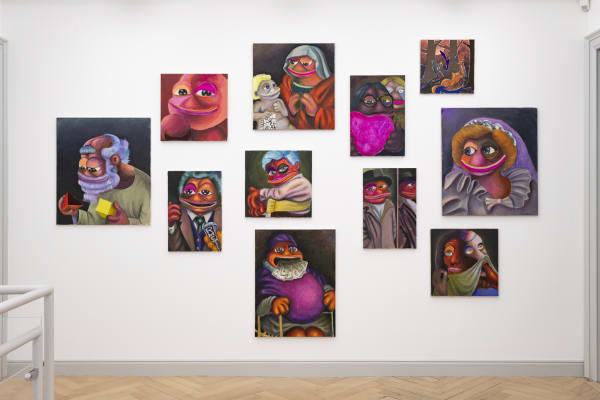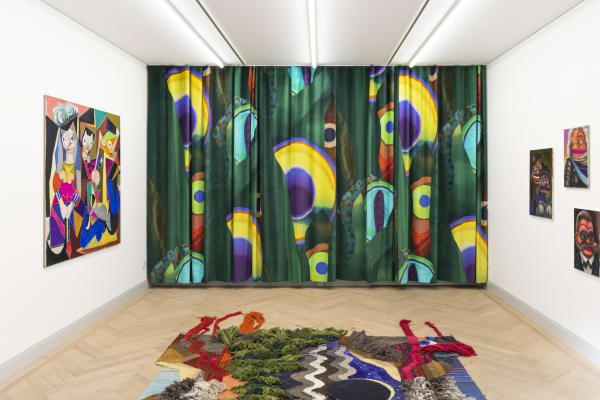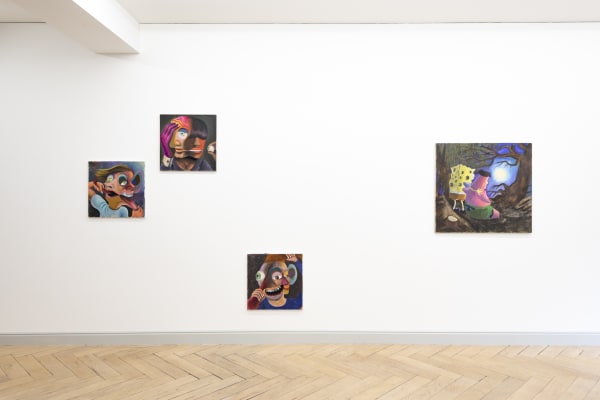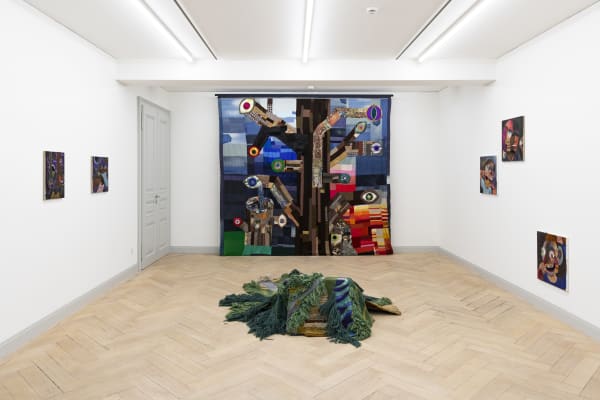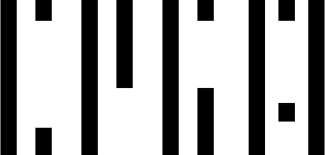Galerie Peter Kilchmann is pleased to to have hosted the duo exhibition of Armin Boehm (b. 1972 in Aachen; lives in Berlin) and Christoph Hefti (b. 1967 in Lausanne; lives in Brussels and Zurich). Upon entering the gallery, visitors are presented with an immersive experience with works on the walls, on the floor as well as free-hanging. The two artists respond to each other in their own language.
This is Armin Boehm's fourth exhibition at the gallery. The paintings on display (each oil and fabric on canvas) in small and medium format, are part of a new series of works portraying well-known personalities as comic memes. The portraits are of European and US celebrities, such as fashion designers, heads of state, royalty and philosophers. Memes are humorous and exhilarating, sometimes satirical and accordingly socially critical images. In Boehm's case, they are often grotesque, frog-like faces, with an optimistic yet ironic aura. The series is also a reference to Martin Kippenberger's "Crucified Frog", a work that sparked fierce controversy in the 1990s.
The individual works blatantly attempt to exaggerate the individuality of the sitters in one way or another and can be read as a rejection of excessive individualism. The artist uses only a few characteristic strokes, in the style of an everyday comic strip, to depict these individualistic personalities - and yet the portraits are unmistakable. The unconcealed wink of Jean Paul Sartre or the authoritarian charisma of Patrizio Bertelli next to the anarchic grin of Miuccia Prada are easily readable.
Boehm's paintings are juxtaposed with Christoph Hefti's two- and three-dimensional works, which complement each other.
For Hefti, this is his first exhibition at the gallery. After studying textiles in Zurich and fashion in London, he began designing for Jean-Paul Gaultier in Paris and Dries Van Noten in Antwerp. After a few years, he decided to work as a freelancer for various fashion houses. This move also allowed him to continue his artistic work. His love for knotted carpets showed him to Nepal, where he has been designing and developing his own series of hand-knotted carpets for several years. During these visits, he seeks direct interaction with the artisans and is fascinated by the exchange of content and textile implementation. He approaches the mystical and even spiritual tradition of the storytelling carpet around its very personal yet worldly themes.
On display by Christoph Hefti are several knotted rugs, a selection of ceramic sculptures with built- in light sources, as well as a large patchwork textile.
As is usually the case with my carpets, various scenarios play out simultaneously and together form a new reality. In the work "The Deer" (knotted wool, hemp and silk, 276 x 202 cm) a deer is posing, as for a portrait, but is wearing a bird mask. Birds flutter around the antlers, their heads covered with deer masks. Since the carpet is supposed to work in all directions, it's not clear if the birds are flying up or falling down. While I realized during Lockdown that the forest, that is, nature, is my driving force - the place where my ideas hide - at the same time in Nepal, moths were destroying the raw yarns in the closed workshops. I took the moths as an inspiration, on the one hand as a decorative element but also as a destructive element. They destroy themselves, because they are part of the carpet. That's why I kept one part unknotted, a technical challenge, and decided to show the normally hidden cotton threads that hold the carpet together - for me the skeleton of the carpet. (But the motif of the moth also serves as a deterrent to the real moths). I only imagined the stag in the forest, I saw it later, when I visited the Musée de la chasse in Paris, hence the humanization of its nature. The antlers of the stag are festively decorated, but without interpretation on the nature of the ritual, while in the background a volcano creates the landscape or destroys it.
This volcanic landscape becomes the main actor in the carpet "Volcano" (knotted wool, hemp and silk, 326 x 248 cm) of the same series. The volcanoes are active, but they do not erupt. They are arranged so that in each case the foot of the crater defines the beginning and end of the carpet, while the lava, as long red strands of yarn made of silk and wool, flow onto the floor of the viewer. Despite the menace, it is a calm and mysterious scene. It is not clear whether it is the first or the last day of the world. The volcanic landscape is shown in daylight, at night and at dawn, that is, in the full day cycle simultaneously. Under the lava, the loose strands of yarn, on each side of the carpet hides a small undefined creature, of which it is not clear whether they are the last or the first creatures in the world. They are so far apart that they are probably unaware of each other's existence. But they stare out of the landscape, the viewer is being observed without knowing.
This reality is reflected in the fabric wall-piece "From the trees" (different materials, 260 x 260 cm) a large patchwork of leftover fabrics from my fashion career, leftover samples of fabric from old archives as well as my own worn out clothes. A landscape of trees that the viewer can contemplate while sitting on a rug-like stool, but at the same time being contemplated by the landscape. The stool itself, "Animal Foot" (hand-knotted wool, silk and hemp, 180 x 154 cm) is a foot of an undefined animal, with claws or paws, overflowing into long thick and undyed wool threads, as fur or feathers. The other seat/reclining sculpture, a kind of carpet chaise longue, depicts a stone woven from wool as well as grass and weeds translated into textile. A giant frog's eye is visible underneath in shiny silk – but only from the viewer's perspective and not if you are lying down on it. – Christoph Hefti
Armin Boehm studied at the State Academy of Art in Düsseldorf with Konrad Klapheck and Jörg Immendorff. Major exhibitions include Kunstverein Braunschweig; Me Collectors Room, Stiftung Olbricht; Berlin, Städel Museum, Frankfurt; Schirn Kunsthalle, Frankfurt; K21 - Kunstsammlung NRW, Düsseldorf and galleries worldwide.
Christoph Hefti studied fashion and textiles at the Zurich University of the Arts and at Central St. Martin's, London. Since 2015 he has dedicated himself to textiles, carpets and ceramics as a freelance artist. Major exhibitions include Dries Van Noten in Los Angeles; Joyce in Hong Kong; galleries and at design fairs.
 Armin BoehmSils Maria, 2022Oil and fabric on canvas50 x 40 cm (19 ¾ x 15 ¾ in.)
Armin BoehmSils Maria, 2022Oil and fabric on canvas50 x 40 cm (19 ¾ x 15 ¾ in.) Armin BoehmEuphoria, 2022Oil and fabric on canvas50 x 50 cm (19 ¾ x 19 ¾ in.)
Armin BoehmEuphoria, 2022Oil and fabric on canvas50 x 50 cm (19 ¾ x 19 ¾ in.) Armin BoehmSuprematisten, 2022Oil on canvas80 x 85 cm (31 ½ x 33 ½ in.)
Armin BoehmSuprematisten, 2022Oil on canvas80 x 85 cm (31 ½ x 33 ½ in.) Armin BoehmMot à Mot, 2022Oil, money notes and fabric on canvas80 x 60 cm (31 ½ x 23 ⅝ in.)
Armin BoehmMot à Mot, 2022Oil, money notes and fabric on canvas80 x 60 cm (31 ½ x 23 ⅝ in.) Armin BoehmFox, 2022Oil and fabric on canvas40 x 40 cm (15 ¾ x 15 ¾ in.)
Armin BoehmFox, 2022Oil and fabric on canvas40 x 40 cm (15 ¾ x 15 ¾ in.) Armin BoehmLes chats de la déraison, 2022Oil and fabric on canvas140 x 150 cm (55 ⅛ x 59 in.)
Armin BoehmLes chats de la déraison, 2022Oil and fabric on canvas140 x 150 cm (55 ⅛ x 59 in.) Armin BoehmUrsprung der Ökonomie, 2022Oil and fabric on canvas67 x 61 cm (26 ⅜ x 24 in.)
Armin BoehmUrsprung der Ökonomie, 2022Oil and fabric on canvas67 x 61 cm (26 ⅜ x 24 in.) Armin BoehmGod's Plan, 2022Oil and fabric on canvas85 x 80 cm (33 ½ x 31 ½ in.)
Armin BoehmGod's Plan, 2022Oil and fabric on canvas85 x 80 cm (33 ½ x 31 ½ in.) Armin BoehmChaste & Fair, 2022Oil and fabric on canvas80 x 71 cm (31 ½ x 28 in.)
Armin BoehmChaste & Fair, 2022Oil and fabric on canvas80 x 71 cm (31 ½ x 28 in.) Christoph HeftiPotential Date 1, 2022Ceramic, glaze, lamp
Christoph HeftiPotential Date 1, 2022Ceramic, glaze, lamp Christoph HeftiDeer, 2022Hand knotted wool, hemp and silk
Christoph HeftiDeer, 2022Hand knotted wool, hemp and silk Christoph HeftiVolcano, 2022Hand knotted wool, hemp and silk
Christoph HeftiVolcano, 2022Hand knotted wool, hemp and silk


